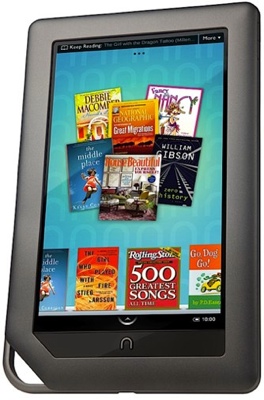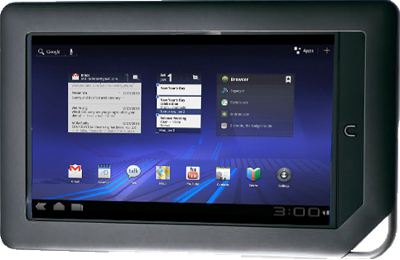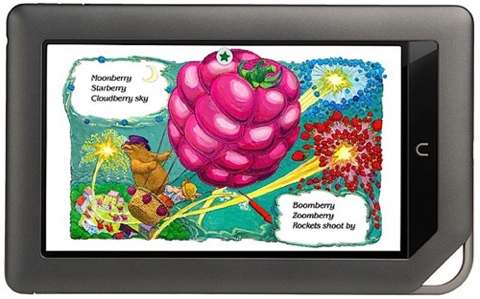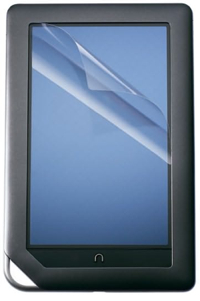Barnes and Noble probably thought they were pulling an "Apple" when they dropped the "N" bomb late last year with the release of the Nook Color eReader, but we seriously doubt that they realized that they had a monster on their hands; an affordable Android-based alternative to the iPad that would attract the attention of hackers worldwide. The original E-Ink Nook was an eReader; it lagged horribly when it tried to do anything else. It was even pretty slow to just change pages in a book (at least at first).
For those who follow the publishing world closely, the Nook was a gamble by Barnes and Noble that has drained a lot of its cash (and at the worst possible time when its same store sales have dropped and rival Borders has decided to close hundreds of stores) but it has also given the world's largest bookstore chain a 25% stake in the exploding eBook marketplace.
Barnes and Noble has sold roughly 3 million Nook Color eReaders, and while that pales in comparison to the 25 million Kindle 3 and iPads that blew out the door in 2010, they have been far more successful at convincing smart phone and tablet users to download the Nook bookstore app; much to the chagrin of the folks at Apple and Amazon. Barnes and Noble earns very little on the sale of the physical Nook, making all of their revenue on the sale of eBooks and digital periodicals.
There has been a rumor for months that the Android Market was coming to the Nook (via a Nook App Market) sometime in early 2011, but based on a recent announcement on HSN (of all places), it would appear that the date is going to be sometime in April. The "April" update is also going to include an update to Android Froyo 2.2 and will add Adobe Flash for a "superior" web viewing experience. The best selling Angry Birds video game will also be available for the Nook Color; not that it hasn't been available for months on a "rooted" Nook Color (think "jailbreak" on an iPhone).
Rooted Nook Color tablets... I mean eReaders, have turned out to be very popular Android-based tablets. Why? At $249, the Nook Color is the most affordable option in a marketplace filled with products from Apple, Motorola, RIM, Dell, and Samsung that are twice the price. The Nook Color may not posses a camera or Bluetooth, or even be 3G-enabled (like the original Nook), but it may be the most practical option for people who want to read eBooks, watch videos, listen to music, and surf the web. It is easy to understand why Barnes and Noble isn't thrilled with the idea that a rooted Nook Color can download the Kindle app (while the reverse is impossible on the Kindle 3), but B&N needs to look at this from a different perspective.

My tablet is better than your tablet...
If the original Nook was all you had to go on, the Nook Color wasn't going to be a marvel of industrial design either. B&N was not about to go out and hire Philippe Starck or Karim Rashid to design their second-generation eReader, but they did take a chance on designer Yves Behar (Jambox, Leaf Light for Herman Miller). Behar has done a great job on the Nook Color, but he may be best remembered for the Nook Hook; a small but handy hook in the lower left hand corner of the Nook Color that is easy to slip a finger through. It is also hides the access port for the MicroSD card. Unlike its predecessor, the Nook Color is slim and very easy to hold. At 8.1"H x 5"W x 0.48"D, it is small enough to schlep around in a large coat pocket, but we suspect that most folks will opt for one of the covers that are available. The Nook Color weighs less than the iPad 2 (which it should considering the screen size difference), but it also heavier than the Kindle 3.
Most of the real estate on the front of the device is taken up by the 7-inch, 1024 x 600 IPS LCD display that offers 169 pixels per inch and a wide 178-degree viewing angle. One of the best selling points of the Nook was that its E-Ink display was easy to read in brilliant sunshine; something that I can confirm having used the Nook at the beach. The Nook Color utilizes what Barnes and Noble calls its "VividView" treatment; the screen's coating is laminated against the display and is supposed to restrict how much light can seep into the screen and cause unwanted glare.
The device is finished in a charcoal-colored plastic, while the back is a smooth, soft rubber that feels good in your hands. On the left side, there is the power/sleep button. B&N has stuck the 3.5mm headphone jack on the top of the Nook Color, with the volume control nearby on the right side. There is a speaker on the rear panel (which you will use more than you think), and the "Nook" button remains on the bottom of the front panel. The original Nook felt cheap; the page turning buttons would crack after too many clicks, but the Nook Color just feels sturdy. Amazon may have made the Kindle 3 light as a feather, but it also made it feel like a toy.
Under the hood, the Nook Color features a TI OMAP 3621 CPU which is clocked at 800MHz. Based on how the rooted Nook Color operates, we suspect that B&N has the stock unit running at less than the advertised speed. The device has 512MB of RAM, 8GB (6000 eBooks...but you'll never get to that point) of flash storage, and the aforementioned MicroSD slot that will accept cards up to 32GB (music and video files). The Nook Color is Wi-Fi only (802.11 b/g/n), unlike the original Nook which offers free 3G service.

The battery life is rated at 8 hours per charge (3 hours), but that is with the Wi-Fi turned off. If you do nothing but read, you should be able to squeeze more out of it, but do not expect the type of performance offered by the E-Ink Nook which could last through 4-5 books. I'm a speed reader.
The overall design of the Nook Color is quite impressive and B&N should not tinker too much with the design in the future; unless they have figured out how to make an already excellent screen even better and not raise the price.
Because running fast is more fun than running slow...
I wish I could say that the Nook Color was designed around a speedy OS. Android 2.1 was always a bit of a slowpoke (sorta like your fat friend in grade school who could never outrun the bully), and even though the Nook Color is a heavily tweaked skin, it suffers from a performance lag due to the software. Android 2.2 should have been the OS version that B&N used, but the clock was ticking and share holders wanted this device brought to market before the holiday buying orgy. Now that we are approaching 3.0, it is understandable why hackers want to use the device with Honeycomb. The Nook Color can handle it (for the most part) and with the Nook Market only weeks away, one would think that B&N would want to maximize its marketability.
The Nook Color boots dramatically faster than the Nook (I've made coffee in a French Press while the old one booted up), and the overall interface is quite slick. The home screen is actually three pages (a simple swipe) where you get to arrange all of your books, periodicals, and recently downloaded content. The screen is actually split into two sections; with your book covers on the bottom that you can scroll by swiping your finger. It isn't smooth like the iPad; there are some frame issues, but the overall feel is quite good. I love the fact that you can move content around and even scale it.
The Nook button always brings you back to the main screen; if you double-click it, it opens to the last page of the last book you were reading. The arrow tab on the bottom of the touchscreen dims the top part of the screen while opening a menu of options along the bottom; library, shop, search, extras, web, and settings.
The seldom-used "Daily" section that exists on the Nook has been replaced with the revamped library that allows you to organize your books, magazines, newspapers, and other docs (music, videos, images). You can ever create personalized shelves that display your favorite reading material. It is dramatically easier to use than the old format on the Nook. B&N has expanded the "LendMe" functionality by allowing you to lend specific books to your email contacts and Facebook friends (you knew that was inevitable). The lending rules have not changed; 14 days and you can only lend it once.
The two biggest changes to the Nook Color are the vastly improved bookstore and the web browser.
The new bookstore interface is simply beautiful and easy to use. The various categories (B&N Top 100, NYT's Bestsellers, New Releases, etc...) open up by touching the "Browse" tab and the covers look fantastic on the color screen. You tap the title and it takes seconds for the transaction to go through and for the eBook to be delivered into your library. The only eBooks that take more time are the illustrated (specific books have been voiced and will read to you) children's literature.

Magazines look great on the Nook Color and they scroll quite easily. You can even make your way through all of the advertisements and focus on the content. Reading the newspaper was a lousy experience on the Nook and it isn't that great on the Nook Color either; the formatting is clunky and page turning doesn't work as well as it does with magazines. This really needs to be addressed.
The biggest joke surrounding the original Nook was its abysmal web browser. I won't even harp on how bad sites looked in E-Ink. The Nook Color is a major improvement, but you won't confuse the Android-powered browser with Safari or Firefox on the iPad or iPad 2. Sites such as our own Big Picture Big Sound home page loaded fairly quickly and the image quality was quite good, but the browser feels sluggish. You can watch YouTube via the Nook Color, but the video quality (on the stock device) isn't the greatest.
Whoever decided to include Pandora Internet Radio on the Nook Color is a true maven. Being able to listen to my favorite stations on a pair of headphones while I read Orwell or Ellroy is an absolute pleasure. It does draw down the battery, but it's too much fun to not use it.
But can you read a friggin book on it?

The page swipes are extremely quick and the reading experience is really quite easy on the eyes. I can read 400 pages in a night and the color screen never bothered me at all. The text is very crisp and even my wife who requires strong reading glasses found it easy on her eyes. The Kindle 3 seems outdated at this point in comparison to the Nook Color when it comes to reading; slower, no color option, and lousy page turning.
Barnes and Noble advertises that there are 2,000,000 eBook titles available on the Nook Color, but that's misleading. There are still more than 1 million free eBooks, but a vast majority are classics (out of copyright), soft-core porn or lousy short stories. The accountants have decided to make it impossible to find the good stuff that is free for the obvious reasons. When you purchase a "free" book on the Nook Color, you get a free trial with www.million-books.com. What a deal. The pricing of the more recent, more popular eBooks is pretty similar to what Amazon is charging.
Turn-Ons:
| Overall | |
|---|---|
| Value | |
| Performance | |
| Features/Ergonomics |